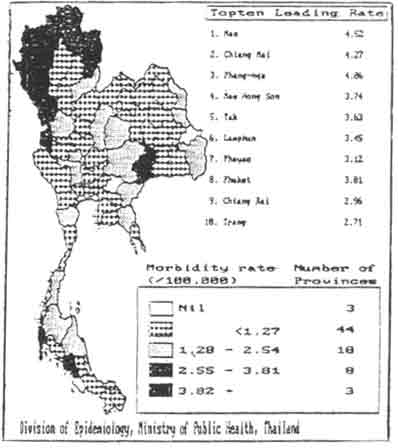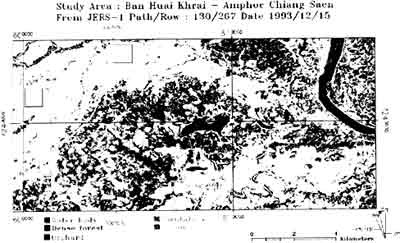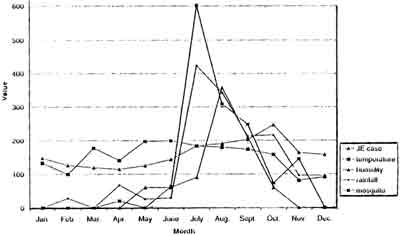| GISdevelopment.net ---> AARS ---> ACRS 1997 ---> Poster Session 1 |
Application of Remote Sensing
and Geographic Information System for Vector-Borne Disease in Humans
Through Rice Agroeco System
Suwannee Adsavakulchai, Dr.
Kaew Nualchawee, Prof. Shunji Murai Dr. Apisist Eiumnoh, Dr. Kiyoshi
Honda
STAR Program, Asia Institute of Technology
P.O. Box 4, Klong Luang Pathumthani 12120 Thaialand
Fax; 66-2-524-6147
E-mail : std77189@.ait.ac.th
Abstract STAR Program, Asia Institute of Technology
P.O. Box 4, Klong Luang Pathumthani 12120 Thaialand
Fax; 66-2-524-6147
E-mail : std77189@.ait.ac.th
Japanese Encephalities ( JE) is one of the vector-brone disease that transmitted to humans through the bite of infected vector mosquitoes that is closely associated with rice agrocosystem . in Thailand, incidence of encephalitis has been highest in the northern region. The relationship between incidence cases of JE and paddy field ( information form satellite remote sensing- JERS-1) and the others environment factors are integrated and spatially analyzed within a geographic information systems. The results of the spatial analysis along with several data sets are further for Japanese encephalitis surveillance system.
Introduction
Vector-borne diseases have been the most important word wide health problems for many years and still represent a constant and serious risk to a large part of the world's population. The major vector-borne diseases that associate with rice fields-Japanese Encephalitis, malaria and schistosomiasis- are well known, an many aspects of the vectors determine the epidemiological patterns ( Mather, 1984). A number of disease associated with rice growing have mosquitoes as the vectors. The best known and most important disease that is transmitted by mosquitoes breeding in rice fields is Japanese Encephalitis. It is transmitted mainly by Culex tritaeniorhynchus, which is often the commonest mosquito in paddy fields.
Japanese encephalitis ( JE) disease is a central nervous system ( CNS) infection caused by a flavivirus transmitted to human by Culicine mosquitoes. Pig are considered to be the main amplifying host . therefore, JE has been considered one of he most serious health problems in Asia, affecting most countries in East, Southeast and South Asia including Thailand. After the first epidemic of JE in Thailand in 1969, there were about 1,500-25,00 reported cases of viral encephalitis form 1970-1985 each year ( Suntharee, 1995) . in addition to strengthening JE disease surveillance, further studies must be conducted. Moreover, the success of JE prevention and control programs, shared information on regional epidemiology and control strategies as well as co-operation from neighboring countries are important.
This paper propose the application of Remote sensing and Geographic information System ( GIS) as tools for the study and surveillance of vector-borne disease in humans through rice agroecosystem in case of Japanese Encephalitis disease in Chiangrai Province, Thailand.
Material and method

Figure 1: Chiangrai Province, Thailand

Figure 2: Study area in from JERS-1 (courtesy from NASDA). In square box is the sampling site.

Figure 3: Encephalitis Vector Mosquitoes
The average temperature is 22-290C in 3 years in the northern region of Thailand. And the precipitate occurs with high precipitate in June-August. The correlation between mosquito abandance data and precipitate is 0.9116 as shown in fig .4. the most type of mosquitoes are related to JE about 63.7-93.2% of total mosquitoes. In Chaingrai Province, the density of mosquitoes is maximum in July and Culex triaeniorhynchus is the dominant species that very high potential for vinous to grow. In addition, no dynamic of JE vector mosquitoes that are the high peaks of vector found in July for 3 consecutive years ( fig 4). However, the density of vectors decrease every year that the average number of maximum in 1992, 1993 and 1994 are 12,050 ( July ), 7,443 ( July ) and 896 ( July ) mosquitoes per trap per night respectively. The relationship between the density of JE vectors and number of JE case rates that are including rainfall, temperature and humidity during 1992 shown in fig 5.

Figure 4: the correlation between mosquito abandance data and precipitate

Fig 5: The relationships between the density of JE vectors and No. of JE case rates that are including rainfall. Temperature and humidity during 1992.
Recommendation
During 1981-1994, the incidence cases of JE in Thailand are 700-2,084 per year respectively. The case rates decreased in 1986 but in the northern regions was still higher than the other regions in Thailand. The reason that the northern part was the highest because the influence of environmental factors and the others such as the climatic condition, misquote density, potential of vectors and population's immunity. The suitable temperature for JE virus growth in mosquito is equal to or more than 280C ( Mogi, 1975). And occurrence of JE outbreaks consistently corresponds with paddy field cultivation in the rainy season. In addition, culex traeniorhynchus is a dominant species that is the highest potential vectors of JE disease, feeding mainly on pigs . Pigs are raised in large numbers in northern Thailand reflected secular amplifying hosts. However, the reduction of JE cases in the northern Thailand reflected secular changes, such as modification in land utilization and increasing urbanization, that have concurrently led to a gradual declined in risk. According to9 the vacination program may be decrease the JE case rates that is not true because the case decrease before vaccine program begin. The vaccine program started in 1987 but the cases decrease in 1986. it can be concluded that the JE cases decreased because the density of JE vector mosquitoes decreased.
Conclusion
There are no dynamic of Japanese encephalitis mosquitoes for 3 consecutive years during January 1992 to December 1994 in Chiangrai Province. Several environment variables may have sufficiently high correction values with mosquitoes abundance to provide a basis for forecasting population densities , including type of potential mosquitoes, density of mosquitoes. For further study, I will be developed model for surveillance of vector-borne disease in Humans Through Rice Agroecosystem in case of Japanese encephalitis disease in Chiangrai Province, Thailand.
Acknowledgement
This report was sponsored by the Japanese Government Project regional Education and Development Program ( REDP)- Education Program (b).
I am also extremely grateful to the Division f Medical Entomology, Department of Medical Science, Ministry of Public Health for available information. Their wholehearthed supported and enthusiasm of this activity are grateful acknowledged.
I would like to thank my examination comities for their helpful comments and suggestion.
Reference
- Aswathanarayana ( 1995). . Geoenvironment . A.A.Balkema./Rotterdam /Brookfield
- Birley, Guidelines for Forecasting the vector-borne disease implication of water resources development. WHO collaborating center: Environmental management for vector control, Department of Medical Entomology, Liverpool School of Tropical Medicine, Pembroke Place, Liverpool L3 5QA United Kingdom .
- Epstein PR, Rogers DJ, Sloff R. ( 1993) Satellite imaging and vector-borne desease. Lancet ; 341:1404-06.
- FAO ( 1984). Environment Management for Vector control in Rice Fields. Irrigation and Drainage Paper 41, pp 152. Distribution and sales section, FAO, Via della Terme di Caracalla, 00100 Rome, Italy.
- FAO ( 1987). Effects of agriculture development on vector-brone diseases. AGL/MISC/12/87. Address as above.
- Horton-Smith ( 1957) Biological Aspect of the transmission of disease. The institute of Biological by Oliver and Boyd Edinburgh. London
- IRRI/PERM ( 1988). Vector-borne Disease control in Humans Through Rice Agroecosystem Management . Proceedings of the Workshop on Research and Training Needs in the field of Integrated Vector -Borne Disease Control in Riceland Agroecosystems of developing countries, 9-14 March 1987. International Rice Research Institute in collaboration with PEM. IRRI communication and Publication Department, P.O. Box . 933 Manila , Philippines.
- Jacques M.May ( 1961) Studies in Disease Ecology . The American geographical society published by Hafner Publishing company, INC., New York
- Mattingly ( 1969) . The Biological of Mosquito- Borne Disease. Geroge Allen @ Unwin Ltd.
- Richared H. Foote and David R.Cook ( 1959) Mosquitoes of Medical Importance. U.S. Government Printing Office, Washington 25, D.C.
- Suntharee Rojanasuphot et al ( 1995). Regional workshop on control strategies for Japanese encephalitis. South Asian Journal of Tropical Medicine and Public Health Vol. 26 Supplement. 3.
- Thavara et al ( 1995). The dynamics of Japanese Encephalitis vector Mosquitoes in Thailand during 1992-1994 . Ministry of public Health Journal Vol. 14 No. 7-9 July September : 70-81.
- UNDP/WORLD BANK/WHO . Tropical Disease Research : A global Partnership. Spectral Programme for research and Training in tropical Disease.
- WHO ( 1972) . Vector control in international health. Geneva.
- Woodruff ( 1974) . Medicine in the Tropics . Longman Group Limited.